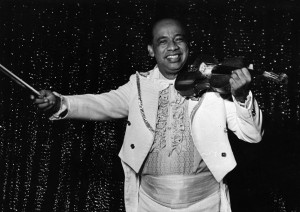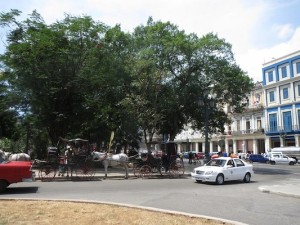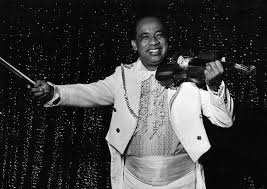LA ESQUINA DEL CHA-CHA-CHÁ..PRADO Y NEPTUNO, LA HABANA.
Es raro que a los comendadores del régimen cubano no se les haya ocurrido hacer su agosto con el soporte cultural que contiene la intersección de estas dos calles, inspiradora de uno de los ritmos cubanos más conocidos en el mundo. Y raro también es que no la hayan rebautizado como la Esquina del Cha-cha-chá.
La rareza, desde luego, no radica en su falta de pericia como comercializadores –algo que resulta bien conocido–, sino en el hecho de que no se hayan aprovechado al máximo de la resonancia cultural de esa esquina, puesto que es lo único que saben hacer: vender nuestras tradiciones como productos turísticos, al tiempo que privan de ellas a su verdadero dueño, el pueblo.
Con la muerte en La Habana del músico cubano Ninón Mondéjar, director de la Orquesta América, se cerró otro capítulo en la historia musical de Cuba, sus intérpretes y sus precursores. Un ciclo que comenzara con una composición musical y un nuevo ritmo que hicieran girar a la conocida esquina habanera de Prado y Neptuno sobre el mundo. A este milagro musical de entonces se le llamó cha-cha-chá y su creador no fue otro que el director musical de esta orquesta y primer violinista, el maestro Enrique Jorrín, quien dejara inscrito, más que un género, su sello propio, y que le colocaría entre las glorias de la música cubana.
El experimento se gestó en la famosa esquina habanera, en las asociaciones “Prado y Neptuno” y “Silver Star”, en uno de sus salones de baile, “Amores de Verano”. Es precisamente en esta sala donde por primera vez se ejecuta la pieza musical que comenzaría toda una época del fenómeno rítmico.
“La Engañadora”, el primer número musical en cha-cha-chá escrito por Jorrín, deja en pocos meses impreso en los anales nacionales, y después en todo el mundo, el sello propio de esta gloria de la música cubana que fuera Enrique Jorrín.
“A Prado y Neptuno
iba una chiquita
que todos los hombres la tenían que mirar
Estaba gordita,
muy bien formadita,
era graciosita,
en resumen, colosal”.
A medio siglo del triunfo mundial del cha-cha-chá, echemos una ojeada sobre este ritmo popular que recorrió el mundo e inmortalizó a una de las esquinas más famosas de La Habana, y que puso a La Habana otra vez en la cadencia musical de sus intérpretes y bailadores desde Buenos Aires hasta Tokio, donde el maestro Enrique Jorrín lleva su música.
¿De dónde salía aquella mujer que puso el mundo a gozar y convirtió a la famosa esquina Prado y Neptuno en el foco musical de toda una época..? ¿Cuál es el origen de la Engañadora..?
El maestro Jorrín se inspiró en una muchacha que un día pasó ante él y un grupo de hombres que conversaban en la esquina de las calles Infanta y Sitios, en La Habana. Ante el desprecio con que la muchacha les miró, uno de los admiradores le dijo: “Tanto cuento y cuando viene a ver son de goma”. En otra ocasión en que Jorrín se encontraba en el desaparecido salón de bailes situado en la esquina de Prado y Neptuno, entró una muchacha delgadita pero que ostentaba un voluminoso trasero. Una moda artificial muy usual en la época. Enseguida le pasó por la mente la pregunta: “¿Esta será otra engañadora? ¿Usará postizos?”.
La Enganadora (Ninón Mondejar)
Lo cierto de todo esto es que el ritmo y “La Engañadora” conquistarían en poco tiempo todo el continente, el mundo bailaba el majestuoso cha-cha-chá, que hoy se mantiene saludable, lleno de vida y de energía como sólo un ritmo del trópico y la creación del maestro Jorrín pudieran alcanzar.
Aún vive en Pueblo Nuevo, La Habana, Agueda Álvarez, a quien se le considera la bailarina que inventó los pasos del cha-cha-chá: uno, dos, tres; cha… cha… chá, y que sirvió como la primera modelo de “La Engañadora”, acompañando en teatros y salones de baile alrededor del mundo a la Orquesta América y a Enrique Jorrín.
“Pero todo en esta vida,
Se sabe, sin siquiera averiguar,
Se ha sabido que sus formas,
Rellenos tan sólo hay.
Qué bobas son las mujeres
que nos quieren engañar.
Me dijiste.
Ya nadie las mira,
Ya nadie suspira,
Ya sus almohaditas
Nadie las quiere apreciar.
En aquel entonces en Cuba había 10.000 vitrolas, alrededor de 100 emisoras de radio, varios canales de televisión —por donde se emitían magníficos programas como “El Cabaret Regalías” de la CMQ— y un sinnúmero de locales y establecimientos donde se reunía el pueblo para escuchar música y bailar.
Silver Star (Ninón Mondejar)
“La Engañadora” fue el primer triunfo del maestro Jorrín grabado con el sello Panart, compañía que pasaba por problemas financieros en esos momentos. La grabación traía del otro lado “Silver Star”, que acompañó triunfalmente también al nacimiento del nuevo ritmo.
Al igual que Jorrín, muchos intérpretes de la música cubana ya no están entre nosotros, pero los recuerdos de su herencia musical para siempre estarán aquí. Nuevas generaciones ocuparán nuestros puestos bailables, es precisamente para que esto continúe sucediendo, motivo principal de este sentido y merecido homenaje a la memoria del maestro Enrique Jorrín.
 THE CHA- CHA- CHÁ CORNER….PRADO Y NEPTUNO STREETS.
THE CHA- CHA- CHÁ CORNER….PRADO Y NEPTUNO STREETS.
It is rare that the commanders of the Cuban regime have not thought of making their August with the cultural support that contains the intersection of these two streets, inspiring one of the best known Cuban rhythms in the world. And it is also rare that they have not renamed it as the Corner of Cha-cha-chá.
The rarity, of course, lies not in their lack of expertise as marketers – something that is well known, but in the fact that they have not taken full advantage of the cultural resonance of that corner, since it is the only thing they know make: sell our traditions as tourist products, while depriving them of their true owner, the people.
With the death in Havana of the Cuban musician Ninón Mondéjar, director of the Orquesta América, another chapter in the musical history of Cuba, its interpreters and its predecessors was closed. A cycle that began with a musical composition and a new rhythm that would turn the well-known Havana corner of Prado and Neptune over the world. This musical miracle of that time was called cha-cha-chá and its creator was none other than the musical director of this orchestra and first violinist, maestro Enrique Jorrín, who left his own label, more than a genre, his own label, and that would place him among the glories of Cuban music.
The experiment was conceived in the famous corner of Havana, in the associations “Prado and Neptuno” and “Silver Star”, in one of its dance halls, “Amores de Verano”. It is precisely in this room where for the first time the piece of music that would begin an era of rhythmic phenomenon is played.
“La Engañadora”, the first musical number in cha-cha-chá written by Jorrín, leaves in a few months printed in the national annals, and later all over the world, the hallmark of this glory of Cuban music that was Enrique Jorrín .
“A Prado and Neptuno
I was a little girl
that all men had to look at her
I was chubby,
very well formed,
I was funny
in short, colossal. ”
Half a century after the world triumph of cha-cha-chá, let’s take a look at this popular rhythm that traveled the world and immortalized one of the most famous corners of Havana, and that put Havana once again in the musical cadence of its interpreters and dancers from Buenos Aires to Tokyo, where the maestro Enrique Jorrín takes his music.
The Enganadora (Ninón Mondejar)
Where did that woman come from who put the world to enjoy and turned the famous corner Prado and Neptune into the musical focus of a whole era? What is the origin of the Deceiver …?
Who was the Deceiver …? (La Enganadora)
The teacher Jorrín was inspired by a girl who one day passed before him and a group of men talking on the corner of the streets Infanta and Sitios, in Havana. Before the contempt with which the girl looked at them, one of the admirers said to him: “Both I tell and when it comes to see they are of rubber”. On another occasion when Jorrín was in the vanished dance hall located on the corner of Prado and Neptuno, a thin girl entered but wore a voluminous butt. An artificial fashion very usual at the time. Immediately the question crossed his mind: “Will this be another deceiver? Will you use hairpieces? ”
The truth of all this is that the rhythm and “La Engañadora” would conquer in a short time the whole continent, the world danced the majestic cha-cha-chá, which today remains healthy, full of life and energy as only a rhythm of tropic and the creation of the teacher Jorrín could reach.
Still lives in Pueblo Nuevo, Havana, Agueda Álvarez, who is considered the dancer who invented the steps of cha-cha-chá: one, two, three; cha … cha … chá, and who served as the first model of “La Engañadora”, accompanying the Orquesta América and Enrique Jorrín in theaters and dance halls around the world.
At that time in Cuba there were 10,000 vitrolas, around 100 radio stations, several television channels -where magnificent programs such as “El Cabaret Regalías” of the CMQ- and countless stores and establishments where the town was meeting were broadcast. listen to music and dance.
“La Engañadora” was the first triumph of maestro Jorrín recorded with the Panart label, a company that was experiencing financial problems at that time. The recording brought the other side “Silver Star”, which also accompanied triumphantly the birth of the new rhythm.
Like Jorrín, many interpreters of Cuban music are no longer with us, but the memories of their musical heritage will forever be here. New generations will occupy our dancing positions, it is precisely for this to continue happening, main reason of this sense and deserved tribute to the memory of the teacher Enrique Jorrín.
Agencies/ Vereda Tropical/ Internet Photos/ Excerpts/ YouTube/ Arnoldo Varona/ www.TheCubanHistory.com
THE CUBAN HISTORY, HOLLYWOOD.

www.TheCubanHistory.com – < SEARCH – OVER 7,000 ARTICLES ABOUT CUBA.







